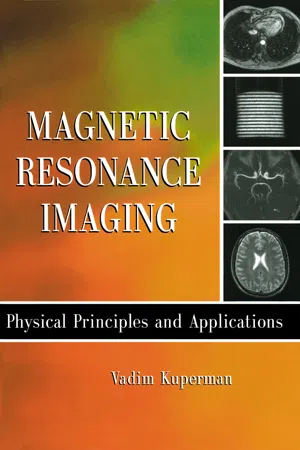
- 182 pages
- English
- PDF
- Available on iOS & Android
eBook - PDF
About this book
This book is intended as a text/reference for students, researchers, and professors interested in physical and biomedical applications of Magnetic Resonance Imaging (MRI). Both the theoretical and practical aspects of MRI are emphasized. The book begins with a comprehensive discussion of the Nuclear Magnetic Resonance (NMR) phenomenon based on quantum mechanics and the classical theory of electromagnetism. The first three chapters of this book provide the foundation needed to understand the basic characteristics of MR images, e.g.,image contrast, spatial resolution, signal-to-noise ratio, common image artifacts. Then MRI applications are considered in the following five chapters. Both the theoretical and practical aspects of MRI are emphasized. The book ends with a discussion of instrumentation and the principles of signal detection in MRI.
- Clear progression from fundamental physical principles of NMR to MRI and its applications
- Extensive discussion of image acquisition and reconstruction of MRI
- Discussion of different mechanisms of MR image contrast
- Mathematical derivation of the signal-to-noise dependence on basic MR imaging parameters as well as field strength
- In-depth consideration of artifacts in MR images
- Comprehensive discussion of several techniques used for rapid MR imaging including rapid gradient-echo imaging, echo-planar imaging, fast spin-echo imaging and spiral imaging
- Qualitative discussion combined with mathematical description of MR techniques for imaging flow
Frequently asked questions
Yes, you can cancel anytime from the Subscription tab in your account settings on the Perlego website. Your subscription will stay active until the end of your current billing period. Learn how to cancel your subscription.
At the moment all of our mobile-responsive ePub books are available to download via the app. Most of our PDFs are also available to download and we're working on making the final remaining ones downloadable now. Learn more here.
Perlego offers two plans: Essential and Complete
- Essential is ideal for learners and professionals who enjoy exploring a wide range of subjects. Access the Essential Library with 800,000+ trusted titles and best-sellers across business, personal growth, and the humanities. Includes unlimited reading time and Standard Read Aloud voice.
- Complete: Perfect for advanced learners and researchers needing full, unrestricted access. Unlock 1.4M+ books across hundreds of subjects, including academic and specialized titles. The Complete Plan also includes advanced features like Premium Read Aloud and Research Assistant.
We are an online textbook subscription service, where you can get access to an entire online library for less than the price of a single book per month. With over 1 million books across 1000+ topics, we’ve got you covered! Learn more here.
Look out for the read-aloud symbol on your next book to see if you can listen to it. The read-aloud tool reads text aloud for you, highlighting the text as it is being read. You can pause it, speed it up and slow it down. Learn more here.
Yes! You can use the Perlego app on both iOS or Android devices to read anytime, anywhere — even offline. Perfect for commutes or when you’re on the go.
Please note we cannot support devices running on iOS 13 and Android 7 or earlier. Learn more about using the app.
Please note we cannot support devices running on iOS 13 and Android 7 or earlier. Learn more about using the app.
Yes, you can access Magnetic Resonance Imaging by Vadim Kuperman in PDF and/or ePUB format, as well as other popular books in Physical Sciences & Nuclear Physics. We have over one million books available in our catalogue for you to explore.
Information
Table of contents
- Front Cover
- Magnetic Resonance Imaging
- Copyright Page
- Contents
- Foreword
- Acknowledgements
- Introduction
- Chapter 1. Basic Principles of Nuclear Magnetic Resonance
- Chapter 2. Excitation of the Transverse Magnetization
- Chapter 3. Basic Techniques for 2D and 3D MRI
- Chapter 4. Contrast in MR Imaging
- Chapter 5. Signal-to-Noise Ratio in MRI
- Chapter 6. Image Artifacts
- Chapter 7. Rapid MR Imaging
- Chapter 8. MR Imaging of Flow
- Chapter 9. MRI Instrumentation: Magnets, Gradient Coils, and Radiofrequency Coils
- Appendix
- Index